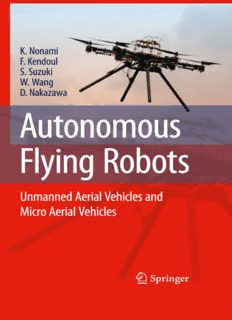
Autonomous Flying Robots: Unmanned Aerial Vehicles and Micro Aerial Vehicles PDF
Preview Autonomous Flying Robots: Unmanned Aerial Vehicles and Micro Aerial Vehicles
Autonomous Flying Robots Kenzo Nonami (cid:129) Farid Kendoul (cid:129) Satoshi Suzuki Wei Wang (cid:129) Daisuke Nakazawa Autonomous Flying Robots Unmanned Aerial Vehicles and Micro Aerial Vehicles 123 KenzoNonami WeiWang VicePresident,Professor,Ph.D. Professor,Ph.D. FacultyofEngineering CollegeofInformation ChibaUniversity andControlEngineering 1-33Yayoi-cho,Inage-ku NanjingUniversityofInformationScience Chiba263-8522,Japan &Technology [email protected] 219NingLiuRoad,Nanjing Jiangsu210044,P.R.China FaridKendoul [email protected] ResearchScientist,Ph.D. CSIROQueenslandCentre DaisukeNakazawa forAdvancedTechnologies Engineer,Ph.D. AutonomousSystemsLaboratory AdvancedTechnologyR&DCenter 1TechnologyCourt MitsubishiElectricCorporation Pullenvale,QLD4069,Australia 8-1-1Tsukaguchi-honmachi,Amagasaki [email protected] Hyogo661-8661,Japan [email protected] SatoshiSuzuki AssistantProfessor,Ph.D. InternationalYoungResearchers EmpowermentCenter ShinshuUniversity 3-15-1Tokida,Ueda Nagano386-8567,Japan [email protected] ISBN978-4-431-53855-4 e-ISBN978-4-431-53856-1 DOI10.1007/978-4-431-53856-1 SpringerTokyoDordrechtHeidelbergLondonNewYork LibraryofCongressControlNumber:2010931387 (cid:2)c Springer2010 Thisworkissubjecttocopyright.Allrightsarereserved,whetherthewholeorpartofthematerialis concerned,specificallytherightsoftranslation,reprinting,reuseofillustrations,recitation,broadcasting, reproductiononmicrofilmorinanyotherway,andstorageindatabanks. Theuseofgeneral descriptive names,registered names, trademarks, etc. inthis publication does not imply,evenintheabsenceofaspecificstatement,thatsuchnamesareexemptfromtherelevantprotective lawsandregulationsandthereforefreeforgeneraluse. Frontcover:The6-rotorMAVwhichChibauniversityMAVgroupdevelopedisshownhereanditssize isonemeterdiameter, 1kgforweight,1.5kgforpayloadand20minutesforflyingtime.Inorderto achieveafullyautonomousflightcontrol,theoriginalautopilotunithasbeenimplementedonthisMAV andthemodelbasedcontrollerhasbeenalsoinstalled.ThisMAVwillbeusedforindustrialapplications. Printedonacid-freepaper SpringerispartofSpringerScience+BusinessMedia(www.springer.com) Preface The advance in robotics has boosted the application of autonomous vehicles to perform tedious and risky tasks or to be cost-effective substitutes for their hu- man counterparts. Based on their working environment, a rough classification of the autonomous vehicles would include unmanned aerial vehicles (UAVs), un- manned ground vehicles (UGVs), autonomous underwater vehicles (AUVs), and autonomoussurface vehicles (ASVs). UAVs, UGVs, AUVs, and ASVs are called UVs (unmanned vehicles) nowadays. In recent decades, the development of un- manned autonomous vehicles have been of great interest, and different kinds of autonomousvehicleshavebeenstudiedanddevelopedallovertheworld.Inpartic- ular, UAVs have many applicationsin emergencysituations; humansoftencannot comeclosetoadangerousnaturaldisastersuchasanearthquake,aflood,anactive volcano, or a nuclear disaster. Since the development of the first UAVs, research effortshavebeenfocusedonmilitaryapplications.Recently,however,demandhas arisenforUAVssuchasaero-robotsandflyingrobotsthatcanbeusedinemergency situationsandinindustrialapplications.AmongthewidevarietyofUAVsthathave been developed, small-scale HUAVs (helicopter-based UAVs) have the ability to take off and land vertically as well as the ability to cruise in flight, but their most importantcapabilityishovering.Hoveringatapointenablesustomakemoreeffec- tiveobservationsofatarget.Furthermore,small-scaleHUAVsoffertheadvantages oflowcostandeasyoperation. The Chiba University UAV group started research of autonomous control in 1998, advanced joint research with Hirobo, Ltd. in 2001, and created a fully au- tonomous control helicopter for a small-scale helicopter for hobbyists. There is a power-line monitoring application of UAV called SKY SURVEYOR. Once it catches power line, regardless of the vibration of the helicopter, with various on- board cameras with a gross load of 48 kg for a cruising time of 1 hour, catching of the power line can be continued. In addition, it has a payload of about 20 kg. Although several small UAVs are helicopters — Sky Focus-SF40 (18 kg), SST- eagle2-EX(7kg),Shuttle-SCEADU-Evolution(5kg),andanelectricmotor-based Lepton (2 kg) for hobbyists, with gross loads of 2–18 kg — fully autonomous control of these vehicles is already possible. Cruising time, depending on the helicopter’s class, is about 10–20 min, with payloads of about 800 g – 7 kg. Thesedevicesarewhatautomatedthecommercialradio-controlledhelicoptersfor v vi Preface hobbyists, because they can be flown freely by autonomousflight by one person, arecheapandsimplesystems,andcanapplychemicalsprays,asinorchards,fields, andsmall-scalegardens.Inthefuturetheycanalsobeusedforaerialphotography, variouskindsofsurveillance,andrescuesindisasters. GH Craft and Chiba University are conducting further research and develop- mentofautonomouscontrolofafour-rotortilt-wingaircraft.ThisQTW(quadtilt wing)-UAVisabout30kgingrossload;take-offandlandingaredoneinhelicopter mode;andhigh-speedflightatcruisingspeediscarriedoutinairplanemode.Bell HelicopterintheUnitedStatescompleteddevelopmentoftheQTR(quadtiltrotor)- UAV, andits firstflightwas carriedoutin January2006;however,the QTW-UAV hadnotexistedanywhereintheworlduntilnow,althoughthedesignandtestflight hadbeenattempted.TheQTW-UAVnowisalreadyflyingunderfullyautonomous conditions.Moreover,SeikoEpsonandChibaUniversitytackledautonomouscon- trolofa microflyingrobot,the smallestin the worldat12.3g, with themicroair vehicle (MAV) advantageof the lightest weight, and have succeeded with perfect autonomouscontrol inside a room through image-processing from a camera. The XRBbyHirobo,Ltd.,about170glargerthanthismicroflyingrobot,hasalsosuc- cessfullydemonstratedautonomouscontrolatChibaUniversity.Flyingfreelywith autonomouscontrolinsidearoomhasnowbeenmadepossible. We have also been aggressively developing our own advanced flight con- trol algorithm by means of a quad-rotor MAV provided by a German company (Ascending Technologies GmbH) as a helicopter for hobbyists. We have chosen this platform because it offersgood performancein terms of weight and payload. TheoriginalX-3D-BLkitconsistsofasolidairframe,brushlessmotorsandassoci- atedmotordrivers,anX-basewhichisanelectroniccardthatdecodesthereceiver outputsandsendscommandstomotors,andanX-3Dboardthatincorporatesthree gyroscopesforstabilization.Thetotalweightoftheoriginalplatformisabout400g includingbatteries,andithasapayloadofabout200g.Theflighttimeisupto20 min without a payload and about 10 min with a payload of 200 g. The X-3D-BL helicopter can fly at a high speed approaching 8 m/s. These good characteristics areduetoitspowerfulbrushlessmotorsthatcanrotateatveryhighspeed.Further- more,thepropellersaredirectlymountedonthemotorswithoutusingmechanical gears, thereby reducing vibration and noise. Also, our original 6-rotor MAVs for industrial applications such as chemical spraying have been developed, and their fullyautonomousflighthasalreadybeensuccessful. For industrial applications, a power-line monitoring helicopter called SKY SURVEYORhasbeendeveloped.Aroughdivisionofthesystemconfigurationof SKY SURVEYOR consists of a ground station and an autonomousUAV. Various apparatuses carry out an autonomouscontrol system of a sensor and an inclusion computer,andpower-linemonitoringdevicesarecarriedinthebodyofthevehicle. The sensors for autonomouscontrol are a GPS receiver, an attitude sensor, and a compass, which comprise the autonomouscontrol system of the model base. The flight of the compoundinertial navigationof GPS/INS or a 3D stereo-visionbase isalsopossibleifneeded.Theprogramflightiscarriedoutwiththegroundstation or the embedded computer system by an orbital plan for operation surveillance, Preface vii if needed. For attitude control, an operator performs only position control of the helicopterwithautonomouscontrol,andso-calledoperator-assistedflightcanalso be performed. In addition, although a power-line surveillance image is recorded by the video cameraof the UAV loadingin automaticcapturemode andis simul- taneously transmitted to the ground station, an operator can also perform posture controlofthepower-linemonitoringcameraandzoomingatanytime. We have been studying UAVs and MAVs and carrying out research more than 10 years, since 1998, and we have created many technologies by way of experimentalworkandtheoreticalworkonfullyautonomousflightcontrolsystems. Dr.FaridKendoulworked2yearsinmylaboratoryasapost-doctoralresearchfel- lowoftheJapanSocietyforthePromotionofScience(JSPSpost-doctoralfellow), fromOctober2007toOctober2009.HecontributedgreatlytotheprogressinMAV research.These factorsare the reason, the motivation,and the backgroundfor the publication of this book. Also, seven of my graduate students completed Ph.D. degrees in the UAV and MAV field during the past 10 years. They are Dr. Jinok Shin,Dr.DaigoFujiwara,Dr.KensakuHazawa,Dr.ZhenyoYu,Dr.SatoshiSuzuki, Dr.WeiWang,andDr.DasukeNakazawa.Thelastthreeindividuals—Dr.Suzuki, Dr. Wang, and Dr. Nakazawa — along with Dr. Kendoul are the authors of this book. The book is suitable for graduate students whose research interests are in the area of UAVs and MAVs, and for scientists and engineers. The main objective of thisbookistopresentanddescribesystematically,stepbystep,thecurrentresearch anddevelopmentin,smallorminiatureunmannedaerialvehiclesandmicroaerial vehicles, mainly rotary wing vehicles, discussing integrated prototypesdeveloped withinroboticsandthesystemscontrolresearchlaboratory(NonamiLaboratory)at Chiba University. In particular, this book may provide a comprehensiveoverview forbeginningreadersinthefield.Allchaptersincludedemonstrationvideos,which helpthereaderstounderstandthecontentofachapterandtovisualizeperformance viavideo.Thebookisdividedintothreeparts.PartIis“ModelingandControlof SmallandMiniRotorcraftUAVs”;PartIIis“AdvancedFlightControlSystemsfor RotorcraftUAVs and MAVs”; and Part III is “Guidance and Navigationof Short- RangeUAVs.” RoboticsandSystemsControlLaboratory KenzoNonami,Professor ChibaUniversity Acknowledgments FirstIwouldliketoexpressmygratitudetothecontributorsofsomeofthechapters of thisbook.Mr. Daisuke Iwakura,who is anexcellentmaster’sdegreestudentin the MAVs researcharea, in particular,contributedChapter 13.Also, I expressmy appreciationtoMr.ShyarilAzradandMs.DwiPebriantifortheircontributionson vision-basedflightcontrol.TheyarePh.D.studentsinMAVresearchinmylabora- tory.Dr.JinokShin,Dr.DaigoFujiwara,Dr.KensakuHazawa,andDr.ZhenyoYu madealargecontributioninUAVresearch,whichisincludedinthisbook.Ialsoap- preciatethecontributionsofDr.Shin,Dr.Fujiwara,Dr.Hazawa,andDr.Yu.During thepast10years,weatChibaUniversityhavebeenengagedinjointresearchwith Hirobo Co., Ltd., on unmanned fully autonomous helicopters; with Seiko Epson on autonomousmicro flyingrobots;andwith GH Crafton QTW-UAV.I thankall concernedfortheircooperationandsupportincarryingoutthejointresearch.Iam especiallygratefultoHiroboforprovidingmylaboratorywithtechnicalsupportfor 10years.IappreciatetheteamworkintheUAVgroup.Iwillalwaysrememberour field experiments and the support of each member. I thank you all for your help andsupport.Lastly,Iwouldliketothankmyfamilyfortheirconstantsupportand encouragement,forwhichIowealottomywife. ix
Description: